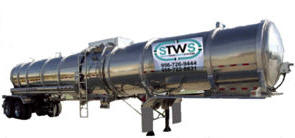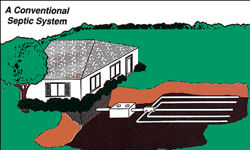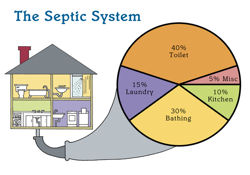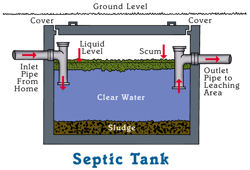|

Septic
Tank Frequently Asked Questions
What is a Septic System?
 A
septic system is an on-site sewage
treatment and disposal system buried underground. It is
composed of a septic tank and a soil absorption area. A
septic system is an on-site sewage
treatment and disposal system buried underground. It is
composed of a septic tank and a soil absorption area.
The modern septic tank is a water-tight box usually made
of reinforced precast concrete, concrete blocks or
reinforced fiberglass, through which no natural bacteria is
able to enter. This structure is where organic solids are
decomposed by a natural enzymatic bacterial process.
The purpose of your tank is to treat household wastes
including body wastes, laundry water, bath water and
discarded food. Septic systems are designed to work
indefinitely if they are properly installed and maintained.
It is critical to have your septic tank pump out regularly
and to maintain proper levels of enzyme and bacterial
action.
 How
Does Your Septic Tank Works? How
Does Your Septic Tank Works?
Waste enters the tank from toilets, Sinks, tubs, and
drains. Organic solid material floats to the top of the tank
forming a layer commonly called “scum.” Inorganic materials
and bi-products from enzyme and bacteria digestion settle to
the bottom of the tank regularly will convert these solid
materials to liquid, which then flow through your
underground pipes to the drain field. In the drain field the
enzymes and bacteria continue to help reduce glazing and
improve soil absorption.
Why Do You Need A Pumping Service?
 Pollutants
from a poorly functioning system can be drawn into your well
and come out in your drinking, cooking and bathing water. If
your tank isn’t cleaned regularly, sludge and scum will clog
the drain field and cause the whole system to fail. Pollutants
from a poorly functioning system can be drawn into your well
and come out in your drinking, cooking and bathing water. If
your tank isn’t cleaned regularly, sludge and scum will clog
the drain field and cause the whole system to fail.
It is important to remove this solid material before it
reaches the level of the discharge outlet and flows into the
drain field. There is a certain amount of material that is
not biodegradable and must be removed by pumping. If your
system should stop or overflow, there could be offensive
odors as well as dangerous health hazards.
 Why
Should You Maintain Your Septic System? Why
Should You Maintain Your Septic System?
A failing septic system isn’t like your car when it is
low on oil; NO RED LIGHT will go
on to warn you. The US Department of Health Services states:
“A septic tank system will serve a home satisfactorily only
if it is properly designed, installed and adequately
maintained. Even a good system which does not have proper
care and attention may become a nuisance and burdensome
expense.
Remember, a septic tank soil absorption system which does
not function properly frequently becomes a neighborhood
health hazard. To obtain satisfactory service, the homeowner
must know something about the design, operation and
maintenance of his own septic tank system.”
How Do You Maintain Your Septic
System?
With today’s modern watertight systems, no natural enzymes
or bacteria can penetrate the walls. The only way necessary
enzymes and bacteria can enter is through your toilets,
sinks tubs and drains. Enzymes and bacteria must be present
to keep your tank working efficiently between periodic
pumping.
Contact us
today for more information and make an appointment. |